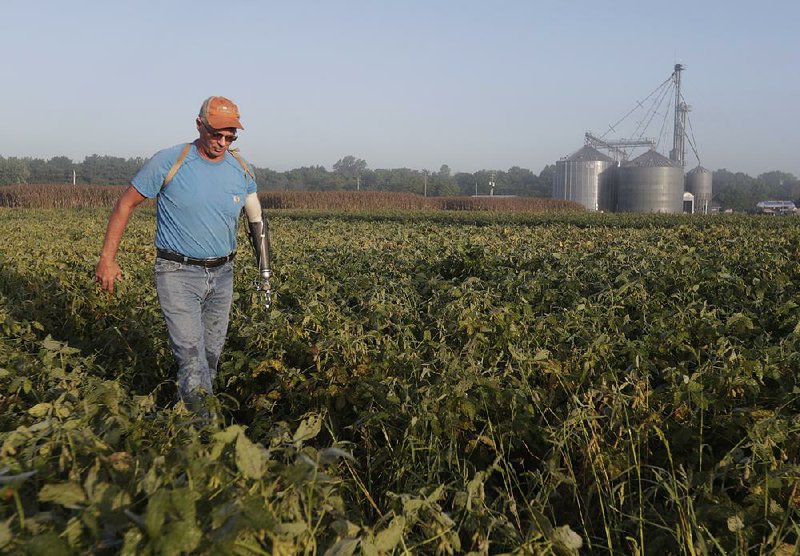WASHINGTON -- Farmers across the United States will soon begin receiving government checks as part of a billion-dollar bailout to buoy growers experiencing financial strain from President Donald Trump's trade disputes with China.
But even those poised for big payouts worry it won't be enough. And while support for Trump is near unwavering in the heartland, some growers say that with the November election nearing, such disappointing aid outcomes could potentially affect their vote.
"It's pretty obvious that the rural agriculture communities helped elect this administration, but the way things are going I believe farmers are going to have to vote with their checkbook when it comes time," said Kevin Skunes, a corn and soybean grower from Arthur, N.D., and president of the National Corn Growers Association.
Corn groups estimate a loss of 44 cents per bushel, but they're poised to receive just a single penny per bushel.
Farmers are already feeling the impact of Trump's trade tiffs with China and other countries. China has hit back hard, responding with its own set of tariffs on U.S. agricultural products and other goods.
The Trump administration is providing up to $12 billion in emergency relief funds for American farmers, with roughly $6 billion in an initial round. The three-pronged plan includes $4.7 billion in payments to corn, cotton, soybean, dairy, pork and sorghum farmers. The rest is for developing new foreign markets for American-grown commodities and purchasing more than two dozen select products, including certain fresh fruits and vegetables, nuts, meat and dairy.
Agriculture Secretary Sonny Perdue announced last month that soybean growers will get the largest checks, at $1.65 per bushel for a total of $3.6 billion. China is the world's leading buyer of American soybeans, purchasing roughly 60 percent of the U.S. crop. But since Beijing imposed a 25 percent tariff on soybeans, import prices have plunged.
The breakdown released by the USDA has stunned corn and wheat farmers who say the payments are uneven and won't do much of anything to help keep struggling farms afloat.
A lobbying group that represents wheat growers is challenging the way the administration determined payments for wheat farmers, who are set to receive 14 cents a bushel. Chandler Goule, chief executive officer of the National Association of Wheat Growers, said the USDA assumed U.S. wheat would be sold to China this year when it made its calculations.
China typically makes its requests for American wheat between March and June. U.S. wheat farmers have sold, on average, 20 million bushels of wheat to China over the past three years. But none came this year, Goule said, as Trump escalated his threatening rhetoric on trade with Beijing.
The response to the bailout among farmers has been mixed. While some are grateful for the help, most are eager for the trade disputes to be quickly resolved.
"Nobody wants to have an aid package. I mean, if you're a farmer you're in the business of producing a crop. We just want a fair price for it," said Joel Schreurs, a soybean and corn producer near Tyler in southwestern Minnesota who sits on the board of both the American Soybean Association and the Minnesota Soybean Growers Association.
His personal operation is about 1,000 acres. He farms an additional 500 acres with his son-in-law and other relatives. He estimates that the tariffs would cost him $40,000 to $50,000 in lost income and that he would get $16,000 to $20,000 in emergency aid.
Schreurs worries that it will be hard for farmers to get back the buyers they'll lose as a result of the trade wars. "And in the short term we have to find another home for those beans, otherwise they're going to pile up and it will keep prices depressed," he said.
In the Midwest, growers typically farm both corn and soybeans. Those farmers would get payments for both under the program, which began sign-ups Sept. 4.
Perdue said checks could start going out as soon as the end of September for crops that have already been harvested; payouts are based on yield.
Daniel Weinand worries the market downturn could be the death knell for his farm. Weinand, 30, grows corn, canola and yellow peas on 900 acres of rented land near Hazen, N.D.
He said he expects to reap about 30,000 bushels of corn, and to receive about $300 in aid.
"A penny a bushel on corn, it's not that it's entirely worthless. But it almost is," he said. "I don't know how many more years I can weather."
Information for this article was contributed by Richard Lardner, Rick Callahan and Steve Karnowski of The Associated Press.
A Section on 09/24/2018

